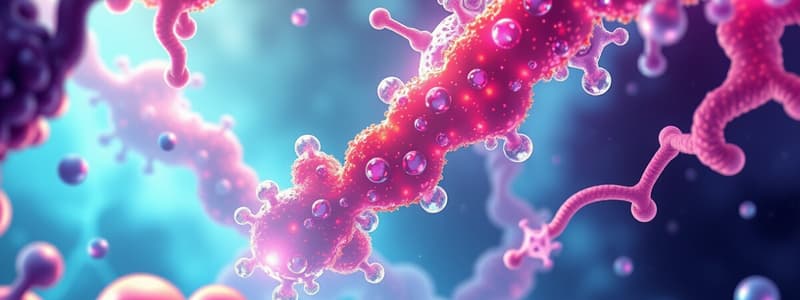Podcast
Questions and Answers
What is a substrate?
What is a substrate?
The specific reactant that an enzyme binds to.
What is an enzyme/substrate complex?
What is an enzyme/substrate complex?
A complex that forms when an enzyme binds to its specific substrate.
What is the active site of an enzyme?
What is the active site of an enzyme?
A restricted region on the enzyme molecule that binds to the substrate.
What does induced fit refer to?
What does induced fit refer to?
How does an enzyme's active site lower activation energy? One way is by _____ substrates correctly.
How does an enzyme's active site lower activation energy? One way is by _____ substrates correctly.
Each enzyme has an optimal _____ and pH.
Each enzyme has an optimal _____ and pH.
What are cofactors?
What are cofactors?
What are coenzymes?
What are coenzymes?
What are competitive inhibitors?
What are competitive inhibitors?
What are noncompetitive inhibitors?
What are noncompetitive inhibitors?
What is an allosteric site?
What is an allosteric site?
What is allosteric regulation?
What is allosteric regulation?
What is an allosteric activator?
What is an allosteric activator?
What is an allosteric inhibitor?
What is an allosteric inhibitor?
What is allosteric activation?
What is allosteric activation?
What is allosteric inhibition?
What is allosteric inhibition?
What is cooperativity?
What is cooperativity?
What is enzyme feedback inhibition?
What is enzyme feedback inhibition?
Flashcards are hidden until you start studying
Study Notes
Enzymatic Concepts
- Substrate: The specific reactant that binds to an enzyme for a biochemical reaction.
- Enzyme/Substrate Complex: The temporary structure formed when an enzyme and substrate interact.
- Active Site: A specialized region on an enzyme where substrate binding occurs, crucial for catalytic activity.
- Induced Fit: A model explaining how the active site of an enzyme adapts upon substrate binding to enhance catalysis.
Mechanism of Enzyme Action
- Activation Energy Reduction: Enzymes lower activation energy through:
- Correct substrate orientation
- Strain on substrate bonds
- Creating a favorable microenvironment
- Covalent interactions with substrates
Environmental Effects on Enzymes
- Temperature and pH Sensitivity: Each enzyme has optimal conditions; for humans, it's approximately 37°C and pH 7.
Enzyme Helpers
- Cofactors: Non-protein chemical compounds that assist enzyme function; can be organic (coenzymes) or inorganic; often derived from vitamins.
- Coenzymes: Organic cofactors that play a role in enzyme activity, necessary for catalysis.
Inhibition Mechanisms
- Competitive Inhibitors: Molecules that compete with substrates by binding to an enzyme's active site.
- Noncompetitive Inhibitors: Bind to a different site on the enzyme, altering its shape and function, making the active site less effective.
Regulatory Sites and Mechanisms
- Allosteric Site: A distinct site on an enzyme, separate from the active site, where regulatory molecules can bind.
- Allosteric Regulation: Modulation of enzyme activity through the binding of effector molecules at allosteric sites.
Types of Allosteric Modulation
- Allosteric Activator: A molecule that binds to an allosteric site, enhancing enzyme activity.
- Allosteric Inhibitor: Binds to an allosteric site, leading to enzyme inactivity by changing active site shape.
Specialized Allosteric Functions
- Allosteric Activation: Increase in enzyme activity upon activator binding to its regulatory site.
- Allosteric Inhibition: Conformational changes in the enzyme prevent substrate binding due to inhibitor binding at the allosteric site.
- Cooperativity: A phenomenon where substrate binding at one active site increases the likelihood of substrate binding at other active sites, amplifying overall enzyme activity.
Metabolic Control
- Enzyme Feedback Inhibition: A regulatory mechanism where the end product of a metabolic pathway inhibits an upstream process, preventing overproduction and conserving resources.
Studying That Suits You
Use AI to generate personalized quizzes and flashcards to suit your learning preferences.





